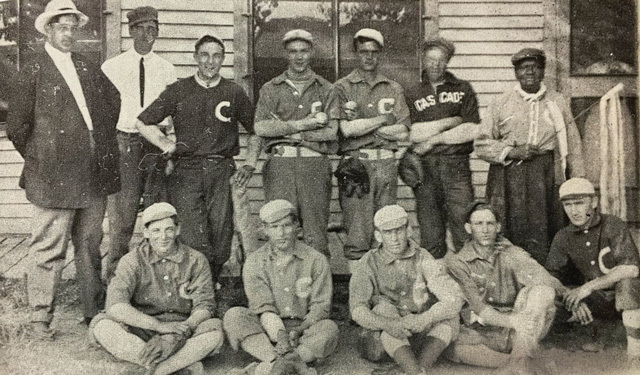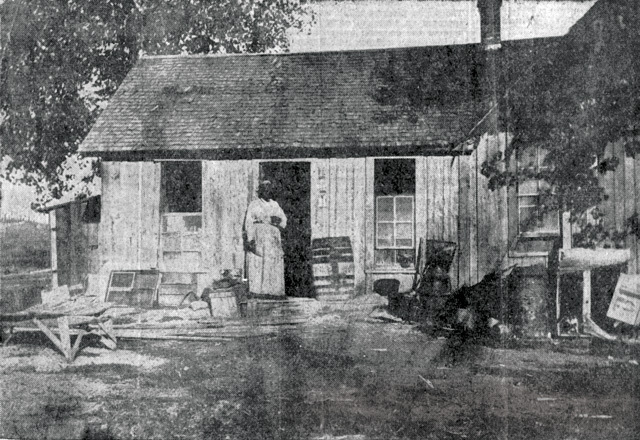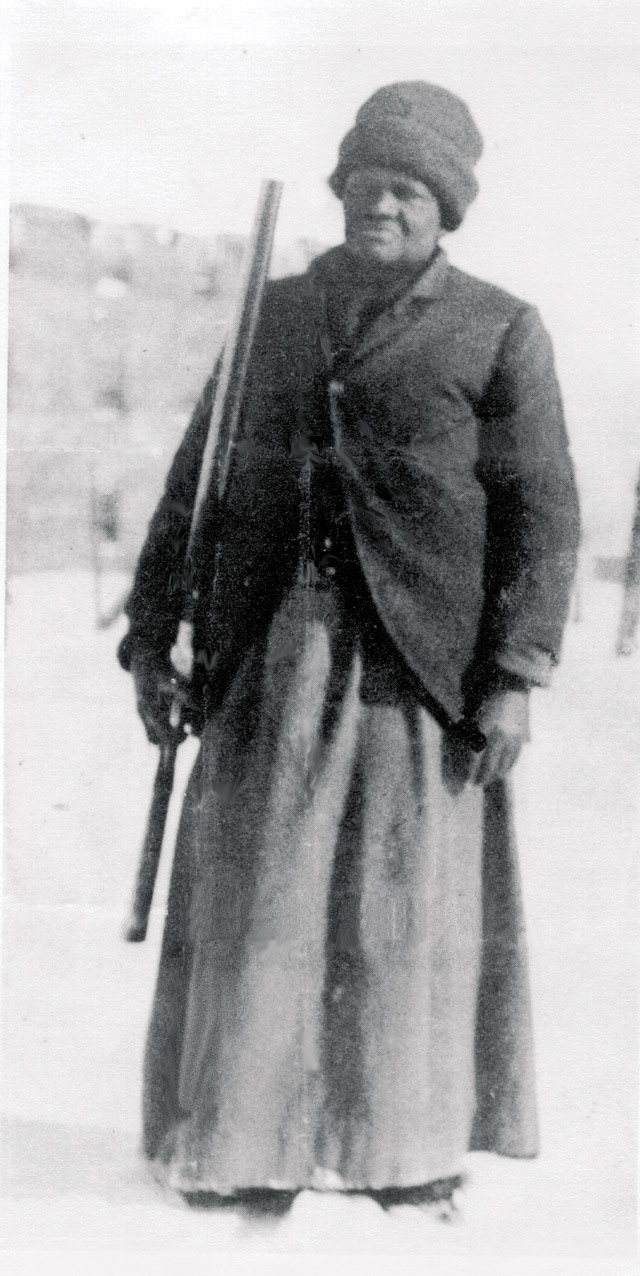Going Postal
A legendary figure in the old West, “Stagecoach” Mary Fields had
to be tough as nails to claim her spot in history as the first African American woman to work as a mail carrier in the United States
PERCHED UP ON her jolting U.S. Postal Service stagecoach, armed with a pistol, a shotgun, and a jug of whiskey, Mary Fields was the first African American woman to work as a U.S. mail carrier out in the new, untamed state of Montana. The year was 1895, and at a towering six-feet tall and approximately 200 pounds, Fields was one tough customer. Quick on the draw, and with a temper to match, she contended with severe weather, wild animals, and the dangers of being a woman alone on the open road from age 65 to 72—a stage of life when most of us would be settling down to collect social security. And in her eight years of cracking the whip and driving her team across the mountains, she never missed a day of work. Clint Eastwood, eat your heart out.
Growing up, Fields probably never imagined she’d be the first of anything. She was born in 1832 in Tennessee as a slave, and was freed during Emancipation when she was in her 30s. She spent many years after Reconstruction working at an Ursuline nunnery in Montana run by an old friends of Fields’, Mother Mary Amadeus. At St. Peter’s Mission, Fields did construction, laundry, gardening, and odd jobs. And in all kinds of weather, she would take the freight wagon to get supplies armed with her .38-caliber Smith & Wesson pistol and a cigar in her mouth.
That gun she always had with her wasn’t just for show. When it came to shooting, Fields “couldn’t miss a thing within 50 paces,” reported Tricia Martineau Wagner in the book African American Women of the Old West. With that skill also came quite a temper. She wasn’t easily intimidated and enjoyed getting a little turnt from time to time, which earned her a reputation as the “terror of the countryside,” and as a woman who had no problem throwing rocks at any man who verbally harassed her.
All of this moxie was great for a future historical figure, but bad for someone associated with the Church. The Catholic Church of the 1800s had no problem turning a blind eye to issues like racism, sexual abuse, and other ills. But having an outspoken Black woman around with the potential to negatively influence the Native American girls they were trying to assimilate into Victorian whiteness was too much for the diocese to handle.
 Fields with her 1876 Winchester carbine rifle
Fields with her 1876 Winchester carbine rifle
The incident that ultimately ended Fields’ employment at St. Peter’s came in 1894 when she had an altercation with a male hired hand. He was upset that she made more money than he did and the two ended up in a duel on church grounds. Fields intentionally shot at the man in such a way that she didn’t seriously hurt him, while still putting him in his place. Nevertheless, when word of the duel reached the bishop, he sent a harshly worded message to the sisters. “Send that black woman away,” he wrote. Not one to shy away from conflict, however, Fields headed off to see the bishop to “Make him bring witness to swear what they have said against me,” as recounted in a 1939 edition of Montana’s The Flathead Courier. Unfortunately, she didn’t win this battle, and Fields was kicked out of the nunnery.
Fields supported herself for a little while after that by running a restaurant, but her generous inclination to feed people whether they could pay or not quickly left her penniless. So in the fall of 1894, at age 64, she responded to a want ad in Montana’s Rising Sun newspaper that would change the trajectory of her life and solidify her legacy in American history. The advertisement, placed by the U.S. Postal Service, stated they were looking for mountaineers to carry the mail from July 1, 1895, to June 30, 1899, on the following routes: “Cascade to Saint Peter’s Mission, every day except Sunday, 17 miles. Fort Shaw, by Florence and Augusta to Cecil, 43 miles, 3 times weekly. Sun River to Choteau, 30 miles, 3 times a week.”
 The Anaconda Standard, Anaconda, Montana, April 7, 1913
The Anaconda Standard, Anaconda, Montana, April 7, 1913
Even at age 64, Fields was the fastest of all the applicants to hitch a team of six horses to the postal coach—securing her the incredibly dangerous job. And despite wagon routes between far-flung Montana towns beset with extreme weather fluctuations—blazing heat, followed by blinding blizzards—she managed to not just survive, but thrive.
Fields perfected her route and fine-tuned it throughout her first and second four-year contracts. And when the weather made wagon travel impossible, she would sling the mail sack over her shoulder and walk 34 miles in snowshoes. This reliability made her an important source of information for those who couldn’t make the trek into town.
As she got to know the folks on her postal route, Fields earned the moniker “Stagecoach Mary,” becoming a local legend in Cascade as an uncommonly powerful woman with skills that were celebrated far and wide. “Mary’s friends claimed [that] if a fly landed on the ear of one of [her horses], she could use her choice of either shooting it off or picking it off with her whip end,” the Anaconda Standard recalled, reverentially, on the 81st anniversary of Fields’ birth. “And if she was in a mind to, she could break the fly’s hind leg with her whip and then shoot its eye out with a revolver.”
Fields also caused local chatter by socializing in the saloons with men. (During that time, the only other women allowed in bars were sex workers.) Not only did her time in the saloons break up the monotony of her long solo treks, but this habit also helped Fields gather information about anything or anyone who might impact her upcoming journeys.
For eight years, Fields faithfully completed her route, even when she faced life-threatening circumstances. Once, during a blizzard, her wagon was stranded in the snow, so she paced all night, refusing to freeze to death.
On another route, a pack of wolves scared her horses, causing them to flip over the carriage. Despite being alone in the darkness, Fields stood watch all night, keeping the wolves at bay with her pistol and shotgun. And when daybreak came, she, the horses, and her cargo were able to return safely.
Fields retired from the Post Office at age 72 and took up full-time residency in Cascade. She started a laundry business, babysat many of the town’s children for $1.50 a day, and became the mascot for the local baseball team, the Cubs, all at the same time. As a mascot, she oiled the bats, cared for the equipment, and cheered on the Cubs during games. She also made flower arrangements for home-run hitters from her garden. But this position also meant being subjected to jeering and taunts from fans of opposing teams.
 Fields with the Cascade Cubs baseball team
Fields with the Cascade Cubs baseball team
“Stagecoach Mary” was so legendary by this time that she made the town seem more interesting that it actually was. But positioning her as a mascot was also a way of stripping her of her humanity. “For whites in Cascade, acquisition of Mary’s status was a comfortable arrangement,” writes historian Miantae Metcalf McConnell in Black Cowboys of the American West, “a perfect modus to keep ‘their’ black resident within the confines of a lower social standing while providing desired notoriety.”
Not everyone was friendly with Fields. And those who dared to cross her, even when she was in her 70s, soon learned she didn’t need anyone to stand up for her. A 1959 issue of Ebony included a story about Fields by actor Gary Cooper, who recalled meeting Fields when he was nine and visiting family in Cascade. Cooper had been a native of Helena, Montana, before becoming a movie star, and had grown up well versed in tales about “Black Mary.” In the piece, Cooper shared one story in which Fields was in a saloon when a man who owed her $2 for laundry walked by. She grabbed him by the shirt collar and knocked him down with her fist. When she returned to the saloon, she announced: “His laundry bill is paid.” “Born a slave somewhere in Tennessee,” Cooper related, “Mary lived to become one of the freest souls ever to draw a breath—or a .38.”
 Fields’ Laundry in Cascade before it was destroyed by fire
Fields’ Laundry in Cascade before it was destroyed by fire
The children Fields babysat, however, remembered only her kindness. Earl Monroe, a man in his late 90s who grew up in Cascade, still recalled details about being cared for by Fields as a child when he was interviewed by the Cascade County Directory in 2006. The son of Cascade’s second mayor, D.W. Monroe, Monroe told his interviewer, “She was a second mother to all the kids…. She always had hard candies and fruit that she would give us. When you walked up to her house, there was an icebox just inside, and she would keep the fruit and candy there…. I remember sitting on her lap. She used to hum and sing songs to me with a deep voice.”
Still, despite being loved by children and having friends in Cascade, Fields was excluded from social activities in her entirely white town. “Membership in auxiliaries, societies, or guilds such as the ‘Ladies’ Aid’ was not available to her,” McConnell points out. Therefore, Fields’ most intimate support came from private friendships. Like many trailblazers of color, her hyper-visibility did not mean better treatment, even after proving herself to be exceptional.
 Fields, once again, posing with her gun
Fields, once again, posing with her gun
Fields’ isolation deepened in 1911, when Cascade made it illegal for all women to enter saloons. It was there, among other rough types, that she had always found companionship. For two long years, she was cut off from her peers, until a new mayor gave Fields special permission to go to bars again and she could finally relax. That peace lasted until 1914, when she got sick.
Fields had fought many enemies, but she was no match for dropsy and pneumonia. She passed away on December 5, 1914, at age 82, in Columbus Hospital. The Cascade Echo reported, “Many were the friends and neighbors gathered to pay homage to her [Fields] who was one of the most loyal citizens.”
Despite her notoriety in Cascade, historians have preserved no direct quotes from Fields outside the anecdotal recollections of others. So, while she is not forgotten, it will always be difficult to create a fully fleshed out portrait of her. Nevertheless, when it comes to figures of note in Black history, we are all too often only taught about paragons of virtue. Fields was something else entirely. The anecdotes told about her life make her sound like a real person; an auntie who would tell tall tales; a friend to go out drinking with; or a companion who would give great advice. Fields never married or had children, but she left behind a legacy that changed the mythology of the American West.
 Great Falls Tribune, Great Falls, Montana, December 9, 1914
Great Falls Tribune, Great Falls, Montana, December 9, 1914
Fields’ story remains an important outlier in pop culture to this day—surrounded by decades of whitewashed, masculine fantasy projects about the “Wild West.” She’s been depicted in two TV movies: The Cherokee Kid (1996—played by Dawnn Lewis) and Hannah’s Law (2012—played by Kimberly Elise). There was a short film called They Die By Dawn (2013—played by Erykah Badu). And she was also celebrated on two TV series: South by Northwest (1974—played by Esther Rolle) and Hell On Wheels (2015/2016—played by Amber Chardae Robinson). Even The View did a segment on her for Black History Month in February 2019.
Be that as it may, “Stagecoach” Mary Fields is still not a household name. Her story should have long ago earned her a place as an icon of the American West—right alongside Doc Holliday and Wyatt Earp. But the more we revive her in our writing, our creative projects, and our imaginations—shotgun shells and all—the closer she’ll be to becoming immortal.
By Princess Weekes
Photos by Archives and Special Collections, Wedsworth Memorial Library
header photo: Fields driving a harvester at St. Peter’s Mission
This article originally appeared in the July/August 2019 print edition of BUST Magazine. Subscribe today!
More from BUST
Meet Mary Fields, the First Black Woman to be Employed by the US Postal Service and a True Badass
A Brief History Of Flappers, Some Of The Original Rule-Breakers
How New Orleans’ “Baby Dolls” Created A Feminist Legacy


